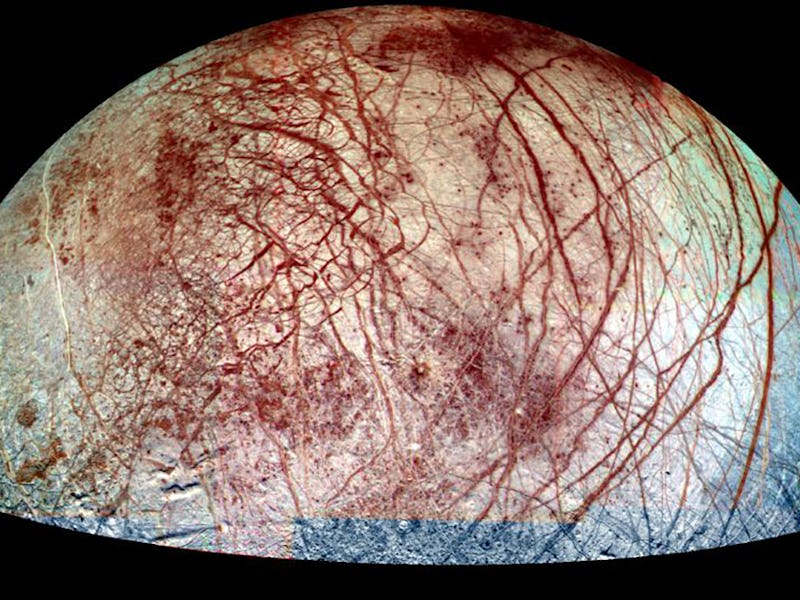Astronomers May Have Just Solved a Salty Mystery at Jupiter's Most Famous Moon
Europa had features that astronomers couldn't previously quite figure out.

NASA’s Galileo spacecraft took an image of Jupiter’s moon Europa in the summer of 2001. In the colorized version there can be seen strange red streaks, appearing almost like the capillaries feeding a giant eyeball.
Those streaks proved to be something of a mystery: Scientists assumed it was a mixture of sodium chloride salts of some sort with water ice, but the chemical signature of these streaks in spectrometer readings don’t match those of any known salts on Earth — the salts on Europa appear to contain more water.
“Salt and water are very well known at Earth conditions. But beyond that, we’re totally in the dark. And now we have these planetary objects that probably have compounds that are very familiar to us, but in very exotic conditions,” Baptiste Journaux, an acting assistant professor of Earth and Space Sciences at the University of Washington said in a statement. “We have to redo all the fundamental mineralogical science that people did in the 1800s, but at high pressure and low temperature.”
Journaux is one of the authors of a new study published Tuesday in the Proceedings of the National Academy of Sciences that did just that, recreating the high-pressure conditions seen in the miles-thick icy crust of Europa in a laboratory and measuring how that changed the formation of ice crystals from a brine mixture. They discovered the first new salty ice water crystal structures found in more than a century, structures that are likely candidates for the strange salty material on Europa’s surface.
”It has the structure that planetary scientists have been waiting for,” Journaux said.
That could help scientists better understand Europa’s potential habitability — the liquid water ocean believed to exist beneath the moon’s icy crust, in touch with a rocky core and heated geothermically, is one of the most promising spots for the development of alien life in the Solar System.
Galileo probe seen in an illustration.
Europa is salty
The key discoveries here are two new chemical structures where salts and water form a lattice held together with hydrogen bonds, known as hydrates. They are the first new hydrates discovered since 1847, when first, and until now, only hydrate was first described.
But hydrohalite doesn’t contain much water in its structure, with just two water molecules for every one salt molecule. The two new hydrates are “hyper hydrated,” with one containing 13 water molecules for every salt molecule, and the other holding 17 water molecules for every salt molecule.
The researchers created brines with varying degrees of salt and then subjected them to intense pressures as high as 25,000 Earth atmospheres between two small diamonds, with the diamonds serving as windows to allow viewing through a microscope.
”Pressure just gets the molecules closer together, so their interaction changes — that is the main engine for diversity in the crystal structures we found,” Journaux said. The crystals, born in high pressure, remained stable as the pressure was lowered to Earth levels, so long as temperatures remained at minus 58 degrees Fahrenheit or colder.
“If you have a very briny lake, for example in Antarctica, that could be exposed to these temperatures, this newly discovered hydrate could be present there,” Journaux said
How it could improve the case for life on Europa
Because salt can act like antifreeze and keep water liquid at colder temperatures, it may play an important role inside Europa, keeping its subsurface ocean in a liquid phase. Understanding the forms that salt takes on the moon could help scientists interpret the findings of upcoming planetary science missions, like NASA’s Europa Clipper mission scheduled to launch in 2024, the space agency’s Dragonfly mission to Saturn’s moon Titan scheduled for 2026, and the European Space Agency’s Jupiter Icy Moons Explorer, which is scheduled to launch in April.
“These are the only planetary bodies, other than Earth, where liquid water is stable at geological timescales, which is crucial for the emergence and development of life,” Journaux said. “They are, in my opinion, the best place in our solar system to discover extraterrestrial life, so we need to study their exotic oceans and interiors to better understand how they formed, evolved, and can retain liquid water in cold regions of the Solar System, so far away from the Sun."
This article was originally published on